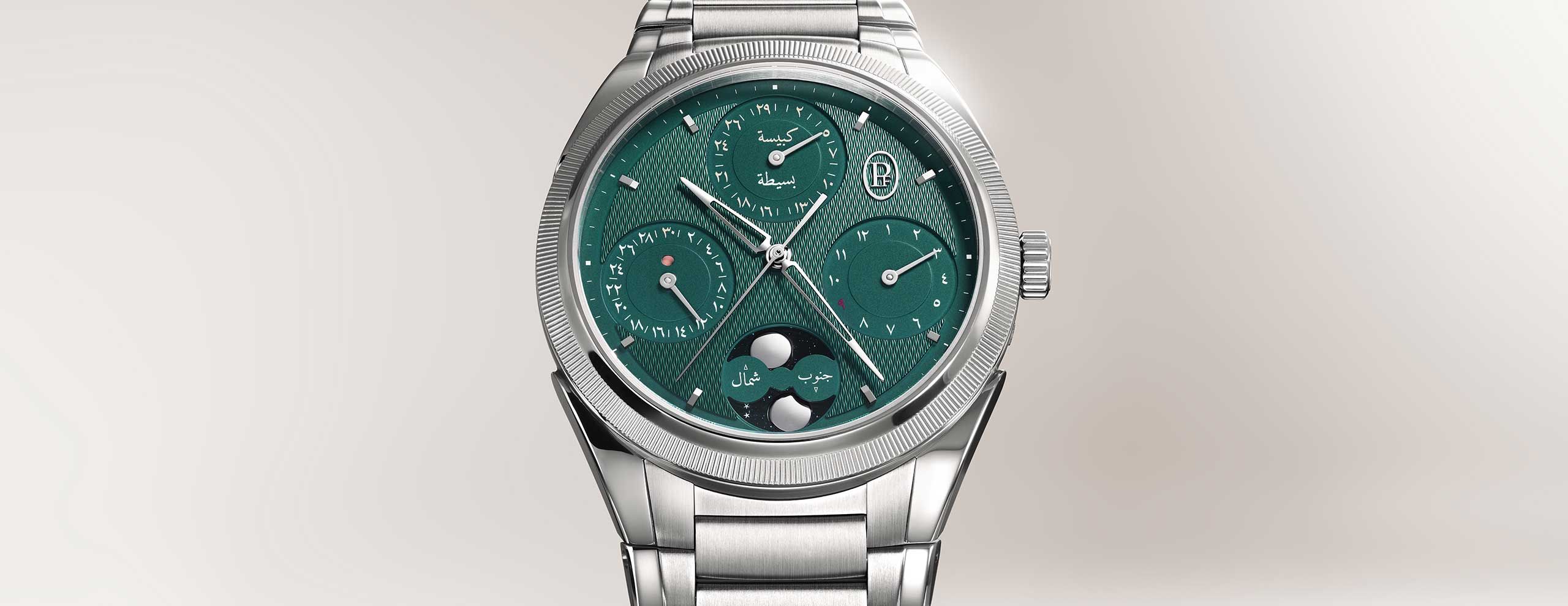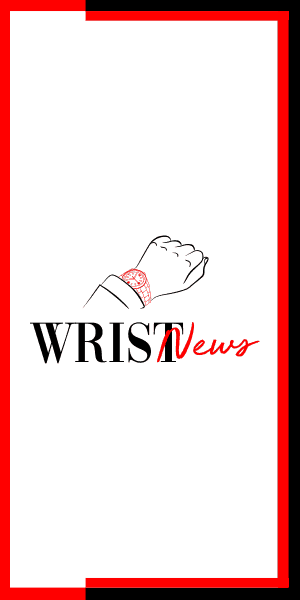Credits: Article and images by Cheryl Chia @ Revolution Watch Magazine. See the original article here - https://revolutionwatch.com/in-depth-parmigiani-tonda-pf-hijri-perpetual-calendar/


The calendar is both an intriguing and beautiful complication as it personifies the purest purpose of timekeeping – to understand and harness the rhythms of existence. While the Gregorian calendar is familiar to many, exploring other calendars offers not only a glimpse into the unique mechanics required to make them but also an opportunity to better understand different cultures and deepen our connections with others.
The Hijri calendar, also known as the Islamic calendar, is a lunar calendar used by Muslims around the world to determine the dates of Islamic religious observances such as Ramadan and Eid al-Fitr. The Hijri calendar begins with the migration of the Prophet Muhammad from Mecca to Medina in 622 CE. This event, known as the Hijra, marks the starting point of the Islamic lunar calendar and is considered one of the most significant events in Islamic history.
While the Gregorian calendar is based on the earth’s orbit around the sun, the Hijri calendar follows the lunar cycle, tracking the time it takes for the moon to complete one full cycle of its phases as observed from earth. Traditionally, each month in the Hijri calendar begins with the sighting of the new moon. This method, rooted in early Islamic traditions, relied on direct observation to determine the start of each lunar month.
However, to overcome the discrepancies in lunar observances across different geographical locations, the Tabular Islamic calendar was developed. It is based on arithmetic rules to ensure precise date determination for religious observances and festivals, and follows a predictable 30-year cycle. It begins with the first month of the year, Muharram, consisting of 30 days, followed by Safar with 29 days and continues with alternating month lengths as the year progresses.
Due to the shorter duration of lunar months compared to solar months, the Hijri year consists of approximately 354 or 355 days. To keep the calendar synchronized with the solar year, the Tabular Islamic calendar occasionally adds a leap day to the last month of the year, Dhul Hijjah, making it a 30-day month instead of the usual 29 days. This adjustment is made in the 2nd, 5th, 7th, 10th, 13th, 16th, 18th, 21st, 24th, 26th, and 29th years of a 30-year lunar cycle, known as abundant years. Remarkably accurate, the Tabular Islamic calendar accumulates only about a day of error in approximately 2500 solar years.
In 2019, Parmigiani Fleurier introduced the first-ever wristwatch featuring a Hijri perpetual calendar. The genesis of this development dates back to 1993 when Michel Parmigiani, the brand’s founder, restored a Renaissance-era pocket watch with an Islamic calendar, displaying the hour, day, date, and month. Inspired by this masterpiece, Parmigiani Fleurier went on to develop the world’s first Hijri Calendar table clock in 2011.
In 2020, the brand debuted the Tonda PF Hijri Perpetual Calendar in platinum, which earned the prestigious Innovation Prize at the Grand Prix d’Horlogerie de Genève. Subsequently, they introduced the first steel version featuring an ice blue dial in the following year, limited to just 25 pieces. This year, Parmigiani has unveiled a regular-production steel model, with a striking viridian green dial.
While Parmigiani has in recent years emerged as a prominent force in watch design, it has been known for its technical competence since the very beginning. The Hijri Perpetual Calendar is a testament to its singularity in the mastery of diverse calendars, forming a trilogy alongside the remarkable Xiali Complete Calendar—a recent addition based on both a solar and lunar calendar—and the Gregorian Annual Calendar.
Tonda PF Hijri Perpetual Calendar
In contrast to a standard Gregorian perpetual calendar, which displays the day, date, month and moon phases, the Tonda PF Hijri Perpetual Calendar displays the date, month, years and moon phases in four sub-dials. The sub-dial at 12 o’clock shows the 30-year cycle with abundant years denoted in beige and common years in white. Another sub-dial at nine o’clock exhibits the date, with the number 30, ۳۰ in beige. It features an aperture that indicates whether the month has 30 or 29 days; a white aperture denotes a 29-day month, while beige signifies a 30-day month. The sub-dial at three o’clock indicates the months of the year in numbers, with the ninth month, Ramadan, in red. Lastly, the moon phase sub-dial at six o’clock features a blue aventurine disc that displays the position of the moon in both the northern and southern hemispheres.
The complexity of a Hijri perpetual calendar stems from having to account for the 11 abundant years in a 30-year cycle, meaning it has to add an additional day on the twelfth month of these years. Unlike a standard perpetual calendar, which relies solely on a 48-month or 12-month program wheel (with a leap year cam or Maltese cross) to encode the leap year, the Hijri calendar requires an additional 30-year program wheel.
It employs a 12-month program wheel with alternating high and low steps that correspond to alternating 30- and 29-day months throughout the year. Interestingly, the 12-month cam and the 30-year cam are mounted on the same axis at 12 o’clock and the calendar system relies on five individual detent-type levers rather than a multipart grand lever.
At the end of each day, a finger on the 24-hour wheel comes into contact with the arm of a large (1) lever, lifting it every 24 hours. The lever then pivots, and another arm advances the date star by one tooth. All this while, the third arm of the lever bears on 12-month cam which, like a standard perpetual calendar, governs the travel of the lever. The high and low steps, decreases and increases the length of travel made by the lever and the second arm that drives the date star. This enables the lever to advance the date star further, when necessary, by two days at once, allowing it to go from the 29th to the 1st. The date star is designed with 29 flat teeth and one sharp teeth.
At the same time, the 30-year cam is designed to distinguish between abundant and common years. It features 11 teeth with flat tips that correspond to the 11 abundant years in a 30-year cycle while its notches encode the 19 common years. There’s a finger is pinned to the 11th notch of the month cam. During common years, this finger rests on the notch of the 30 year-cam and goes undetected by the large lever. However, during an abundant year, the finger rest on the flat surface of the tooth of the year cam and prevents the large lever from reaching the full depth of the notch in the month cam. As such, the lever makes a smaller travel, advancing the date star by one step instead of two, accounting for the additional day at the end of the 12th month.
The 30-year cam is affixed to a 30-year star that is advanced by a second (2) lever at the end of each year. The free arm of the lever locks into the year snail, which is mounted on the pivot of a 12-month ratchet wheel, thereby driving the 30-year star one tooth forward with the help of a spring.
Despite its apparent complexity, this mechanism offers an ingeniously elegant solution to what could otherwise be a much more complicated, finicky, and potentially less reliable system. The 12-month cam is felt by a third (3) lever that has a rack on its free arm. This rack meshes with the pinion of a bi-coloured indicator piece, enabling the aperture on the date sub-dial to turn peach on months with 30 days and white on 29-day months.
The basis of this watch is a full-rotor automatic movement with a platinum oscillating mass, serially coupled double barrels, a directly driven central seconds and a free-sprung balance wheel. It operates at 28,800 vibrations per hour (4 Hz) and has a power reserve of 48 hours.
What makes it all the more compelling is that the highly unusual calendar is housed in a Tonda PF, a highly elegant and original take on the integrated bracelet sports watch that has earned itself quite the following in recent years. The case is in stainless steel and is depth rated to 100m. It has a narrow, fluted bezel made in platinum, which gives it lustrous shine that subtly differs from steel. Thanks to its short downturned lugs, its 42mm by 11.2mm dimensions offers the collection’s hallmark of sitting low and snug on the wrist while having a bold presence.
The dial is in a rich, jewel-toned shade of green, fitting for a watch that is equipped with such a mechanically unique perpetual calendar. Like the rest of the collection, it has been engraved with a fine barleycorn guilloché pattern. The indexes and hands, made of gold and steel respectively, are rhodium-plated and are highly polished, offering excellent legibility against the visually dynamic dial. It all makes for a watch that would appeal to those who loved the design, fit and finish of the time-only Tonda PF but might have found the dial to be overtly minimalist. But even as far as perpetual calendars go, the general composition is still remarkably elegant.
As with the rest of the Tonda PF collection, the watch has an abundance of style, but at its core, it is a highly accomplished perpetual calendar with an elegance in execution both inside and out.
Tech Specs
Tonda PF Hijri Perpetual Calendar PFH983-1020001-100182
Movement: Automatic calibre PF009; power reserve of 48 hours; 4Hz or 28,800vph
Functions: Hours, minutes, seconds; Hijri perpetual calendar
Case: 42mm x 11.2mm; Polished and satin-finished stainless steel with platinum 950 knurled bezel; water resistant to 100 metres
Dial: Viridian green; Grain d’Orge guilloché; 18ct gold rhodium-plated appliques; moon phase disc in blue aventurine
Strap: Polished and satin-finished stainless steel bracelet with folding clasp
Price: CHF 62,500, or USD 67,200
Credits: Article and images by Cheryl Chia @ Revolution Watch Magazine. See the original article here - https://revolutionwatch.com/in-depth-parmigiani-tonda-pf-hijri-perpetual-calendar/











